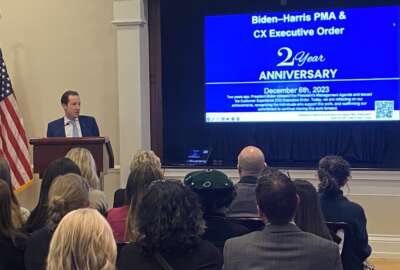Agencies should expect more pooled hiring actions in 2024, OPM’s Shriver says
Office of Personnel Management Deputy Director Rob Shriver said there will be a continuing and increasing emphasis on pooled hiring in the coming months.
Over the next year, the Office of Personnel Management is planning to expand on one recruitment strategy that has already seen small-scale success: pooled hiring.
“You’re going to see a continuing emphasis on that because it just makes sense from a resource perspective,” OPM Deputy Director Rob Shriver said in an interview with Federal News Network.
Pooled hiring takes place when one agency, who’s already hired the candidates it needs off a list of qualified applicants, then shares that list with other agencies looking to onboard candidates for the same position. It can be particularly beneficial, for instance, to agencies who may have fewer HR resources, if they can lean on larger agencies and departments for support.
“There are some agencies that do a great job recruiting high-quality talent pools and have great assessments for those — they may get way more qualified candidates than they can bring on board,” Shriver said. “But other agencies want to hire people in that job too. Why shouldn’t we leverage all that investment that particular agency has made in the recruiting and assessment process, so that other agencies can hire from that certification?”
Agencies have the authority to create pooled hiring actions from a 2015 law, called the Competitive Service Act. But for years, few agencies actually took advantage of the recruitment strategy. Even now, Shriver said, there’s still room for growth in agencies pooling their resources when hiring.
“There hasn’t been as much uptake of that to this point,” Shriver said. “There’s been some experimenting with it that has been very promising. We’re going to continue to try to expand that in 2024.”
When the pooled hiring actions stem from individual agencies, Shriver said he sees OPM’s role in the process as a “strategic advisor.”
“We can work with them from the very beginning of that hiring process, so that when they generate a certification that has a lot of great candidates, that can be made available as well,” he said.
Another way OPM has tried to support agencies was by launching a talent pools platform on USAJobs in December. The idea is to streamline the process for agencies actually sharing certificates during recruitment. Currently, there are posts for agencies looking to hire IT program managers, IT specialists and data scientists governmentwide.
Alongside individual agencies, OPM also has the authority to launch governmentwide pooled hiring efforts — it’s a strategy that OPM used to help many agencies hire under the Infrastructure Investment and Jobs Act, commonly known as the Bipartisan Infrastructure Law (BIL).
Shriver said, for instance, that agencies involved in BIL first needed more staffing in their HR departments. OPM launched a governmentwide pooled hiring action for that exact reason. Then, the actions proved helpful in hiring for other infrastructure positions, as evidenced by agencies exceeding their hiring targets last year.
“I think you’re going to see more of that in 2024,” Shriver said.
And plans are already laid out to expand pooled hiring in the coming months. One upcoming goal of the President’s Management Agenda (PMA) is to launch eight pooled hiring efforts over the next year to support multi-agency hiring. By comparison, OPM held five governmentwide efforts, and hired 400 people through those efforts, over the last year.
In 2023, OPM also held a briefing for agency leaders aiming to help them understand pooled hiring, and how agencies can participate in shared hiring actions, a December PMA update said.
Even though pooled hiring ultimately aims to make the hiring process easier by combining agencies’ resources, it’s still a challenging task. And it’ll take more resources to get it off the ground over the next year, Shriver said.
“Every year, we ask for funding in the budget to be able to invest in these pooled hiring actions,” he said. “Then we work with chief human capital officers and evaluate where the greatest need is for pooled hiring that OPM can manage.”
OPM’s internal challenges can also make it more difficult to step up to the task. In 2023, the Government Accountability Office reported that OPM is at “significant risk” of being unable to help agencies address governmentwide skills gaps, if it can’t first do a better job of addressing its internal skills gaps.
OPM’s workforce size — just shy of 2,700 employees — is also relatively small compared to the amount of work it handles governmentwide.
“Then you look at the folks that actually work on these big cross-government HR initiatives and it starts to look small really, really fast,” Shriver said. “The numbers are somewhat deceptive, because the vast majority of our staff works on either retirement services or on the Federal Employees Health Benefits program … We have spent a lot of time working not only to rebuild resources for the agency, but to build trust and build a supportive, engaging environment.”
Copyright © 2025 Federal News Network. All rights reserved. This website is not intended for users located within the European Economic Area.
Drew Friedman is a workforce, pay and benefits reporter for Federal News Network.
Follow @dfriedmanWFED






